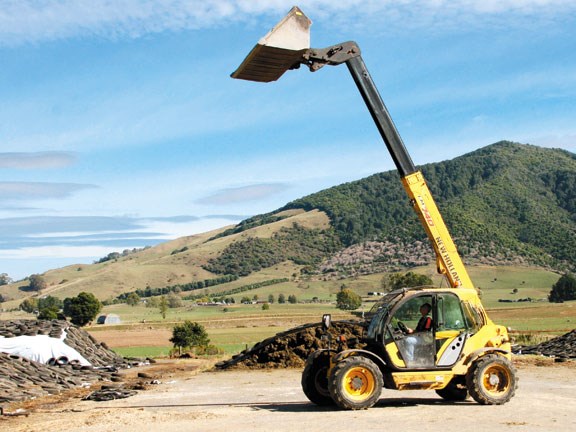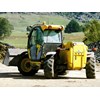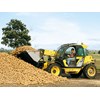New Holland LM740 telehandler







|

|

|
The New Holland LM740 telehandler is a versatile vehicle in a class all on its own

|
|
New Holland LM740 telehandler
|
- Simple controls
- Excellent stability
- Ability to reach over walls
- Extremely versatile, suitable for many industries
- Three steering options
Telehandlers are interesting vehicles - a kind of crossover vehicle. They're not a tractor and they're not a forklift, yet, with large tyres and good stability, they can do both.
They are popular around the world because they are so versatile. Their reach over walls and fences is especially handy.
The test
I drove Dave Forsythe's New Holland LM740 on his property near Te Awamutu. His telehandler has clocked up 1258 hours in two and a half years of operation.
Forsythe View is a 243ha farm with a contract milker and five support staff looking after 1050 cows. Feeding out is one of the most important roles and requires considerable time input.
Five times each day the 14-tonne (loaded) feed mixing wagon is filled with a combination of ingredients and supplements before being towed by a tractor to be spread in rows in designated paddocks. Forsythe reckons his New Holland telehandler is about 50% faster than using his New Holland tractor with a front end loader to load the mixing wagon.
Forsythe says, "The telehandler is pretty quick. We have maize silage, palm kernel, potatoes, grass silage, lime and minerals, so there's quite a lot to go in. It's a good loader machine too, whereas the tractor is not a good loader. You can use the boom for a higher reach, so it's a bit safer, and we've had no damage either, using the telehandler."
The New Holland LM740 is also used to clear stock effluent and load it into the "spreader" from the "herd home" dry shed. The pallet forks are used to remove the floor slats and then the bucket to clear the effluent. The oversized bucket makes the task fast.
A quick swap of the bucket for lifting forks about twice a week changes the telehandler's role to allow incoming trucks to be unloaded, which might carry palletised items such as calf meal and bagged feed supplements. Another use is to load straw bales with the pointed bale forks.
The vehicle is also capable of towing when fitted with the correct hitch.
Engine and power
The CNH 4TAA powerplant produces 88kW (120hp) of power at 2200rpm and 525Nm of torque at 1400rpm from 4.5 litres displacement. Built in Italy, the four cylinder Tier 3 motor runs individual Bosch injectors fed by an after-cooled turbocharger.
The engine and transmission is mounted on a trio of rubber vibration dampers on the right-hand side of the vehicle to centre the boom.
The cab and instrumentation
Inside the roomy cab there are very few controls to learn to use.
The joystick controls the boom rise and fall, with a toggle switch for the boom extension, which has a maximum of 4.1m extension. A left-right action on the joystick operates the crowd to empty the bucket.
To the left of the analogue dash displaying rev, engine temp and fuel level, is the three-way electro-hydraulic wheel steer switch.
For general use and travelling, operators should employ front wheel steering only. For high manoeuvrability you can engage the four wheel steer option. The third option sees operator set all four wheels point at the same angle in the same direction, allowing the vehicle to "crab" forward and sideways at the same time. This mode can be handy when you need to get into a narrow gap with restricted access or to position a pallet.
The New Holland LM740 was unbelievably quiet inside, even with a window wide open, maybe enhanced by the rubber mounts that support the cab.
Looking outside, the low boom offers good visibility; however sitting off-centre to the left it becomes more challenging to prevent the poorly visible right side from hitting obstacles.
Performance and handling
The 40km/h four-speed Powershift transmission system provides both transport and workhorse flexibility. The well-used LM740 made pretty rough changes going up or down the gears. Because it made a hard jolt take-off in first, I found using the less sensitive second gear suitable for loading and unloading work, and the engine was easily able to hold that gear.
Read in-depth machinery reviews in the latest issue of Deals On Wheels magazine, on sale now.
See telescopic handlers for sale.
Keep up to date in the industry by signing up to Deals on Wheels' free newsletter or liking us on Facebook.

.jpg)

.jpg)

.jpg)

